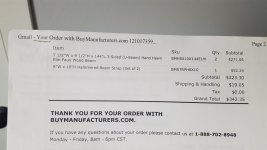Since Rob asked, we'll talk about floor heat now.

I was in my new shop thru last Winter and use Hydronic Radiant Floor heat in it as well as in the house. I use Rinnai Propane fired Tankless 199,000 btu Heaters. They are condensing heaters with efficiency rating somewhere around 96%. The shop heater is vented using 3" PVC, intake and exhaust. The house heater uses 2" PVC. I run the shop heater on 120F. House heater on 110F. Still experimenting with which might be best. I use a simple on/off thermostat in the house. I use a better multi function thermostat in the shop that measures air temp and concrete floor temp. Experimenting with that too.
The shop is 39x48x14, 1872 sqft, uses 9 loops of 250ft each (2,250ft), 1/2" PEX, stapled to 2" pinkboard insulation, chaired rebar above that, 6" concrete slab. All on one zone.
The house slab is 54x32x09 plus 18x40x09, 2448 sqft, uses 13 loops of 250ft each (3,250ft), 1/2" PEX, stapled to 2" pinkboard insulation, chaired rebar above that, 5" concrete slab. All on one zone.
Both systems will over run if conditions are right (wrong). Over run meaning the air temp in the building may be higher than the thermostat setting.
For example, right now thermostat set on 69 in my shop. Mid Afternoon. Sunny. 23F degrees this morning. 4 p.m. outside temp is 43F degrees. Temp in the shop now is 72. I'm experimenting with the thermostat that also uses slab temp to try to control the system from overheating the slab. I don't have as much problem if it's cloudy. Nor do I have as much problem if temps are colder.
The house right now is set on 71F degrees, current temp in the house is 72F. It doesn't seem to overrun as much as the shop.
Neither building ever drop below the thermostat setting. Have experienced -10F using the shop system with no problems keeping up.
My systems are very simple. They are considered "open" systems. This means the building water supply is constantly open to the heat system using a backflow preventer and a 15psi regulator. After the supply regulator there is a T, one side is the water exiting the floor loops, other side goes to a "burp" tank. This gets rid of any air that might show up in the system and softens the pressure so there's no jar when it kicks on/off. Out of the tank to the inlet of the heater. Output of the heater goes to the pump. Output of the pump goes to the manifold pushing hot water into the floor loops.
This system functions as follows. Thermostat calls for heat. Pump starts moving water. Heater senses this movement and fires up. Pump moves water at about 3gpm. Heater regulates burner to maintain setting temp. 120F in shop. 110F in house. When thermostat is satisfied it turns off pump, which stops water movement and heater shuts down.
Both of my systems have pretty long run times. With temps 20F to 40F they may only run once a day.
I think this might be contributing to my overruns. So I swapped in the dual thermostat. So I set the air temp at 69F with 1F variation. I set the slab temp at 75F maximum, 69F minimum. The probe is about 3ft from the pipes going into the slab. Concept being if the slab temp reaches 75F before the air temp is satisfied the heat will kick off. Slab temp drops a degree and the heat kicks back on. Running shorter but more often cycles and not over heating the slab so much.
So far I haven't saw the results I wished for but I haven't sampled this in real cold weather yet. I'll report my findings then.

